Marion and the Forty Thieves
Few historians in Australia engage in the world of creative non-fiction … Even fewer have written creative non-fiction for children … Luke’s book is an exemplar of what historians can do to reach diverse audiences, to make history accessible and allow readers to look to history for inspiration.
READ REVIEW
↓
marion and the forty thieves
sarah luke | 2024
Few historians in Australia engage in the world of creative non-fiction. A couple of names come to mind: Richard Flannagan, who has a Master of Letters in History from Worcester College, Oxford; Peter Cochrane, whose novel The Making of Martin Sparrow was shortlisted in 2019 for the Voss Literary Prize; and Kiera Lindsey, who writes speculative biography. Even fewer have written creative non-fiction for children. Among them is Anna Clark who wrote Convicted! The Unwonderful World of Kids, Crime and Other Convict Capers. The most recent contributor to this small but important body of literature is Sarah Luke.
Marion and the Forty Thieves is based on the meticulous research Luke undertook for her book Like a Wicked Noah’s Ark: The Nautical School Ships Vernon & Sobraon. Set in the early 1890s, it is a vivid account of life for more than 300 boys under 16 years of age aboard a floating school permanently moored off Cockatoo Island. Most had been arrested after being caught for truanting or loitering in public. It also provides a marvellous picture of life at that time in and around The Rocks, and the violent pushes (gangs) that robbed and terrorized many Sydneysiders.
The story, which builds up to a swashbuckling ending with the Sobraon being set on fire by the Forty Thieves push – captained by the notorious Joseph Bragg – centres around Marion Neitenstein, daughter of the school’s principal. Marion was a real person. So too was Joe Bragg. His life was well documented in court records, which detail 15 convictions resulting in imprisonment and a stretch in the Tarban Creek Lunatic Asylum. But Marion’s historical footprint is faint.
Luke has done an impressive job of resurrecting Marion. Elsewhere, in a chapter entitled ‘The Problem of Ghostly Girls’, Luke raises issues around historians incorporating fictional and creative non-fictional techniques into historical representations:
For some, this idea of “polluting” biography or history with fiction – even if it is well researched, convincing and aligns with the personality in question – is disturbing. For others, to deny the historical authenticity of these hybrid approaches is to deny women of the past a voice. They argue that if these approaches aren’t appreciated then the stories of many women would not be published due to their fragmentary nature, especially compared to those of men. … [and] … what about children? And, to be even more specific, girls?
Luke’s book is an exemplar of what historians can do to reach diverse audiences, to make history accessible and allow readers to look to history for inspiration. In the early twentieth century, French novelist Andre Gide wrote that certain ‘critics of no little discernment have considered that fiction is history which might have taken place, and history fiction which has taken place’. History is a literary activity and Luke has risen superbly to the challenges of being a writer. I thoroughly enjoyed reading Marion and the Forty Thieves. I am confident that its main readership – late primary and junior high school students – will too. Teachers of reluctant readers or ‘historyphobes’ will also find this novel useful in connecting people with the past. (Luke, too, has provided teaching notes which tie her work into relevant curricula.)
Marion and the Forty Thieves is published by National Library of Australia Publishing.
Reviewer: Paul Ashton, PHA (NSW & ACT)

